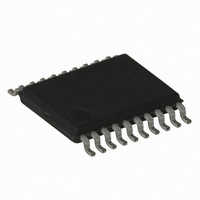ATTINY167-15XD Atmel, ATTINY167-15XD Datasheet - Page 35

ATTINY167-15XD
Manufacturer Part Number
ATTINY167-15XD
Description
MCU AVR 16K FLASH 15MHZ 20-TSSOP
Manufacturer
Atmel
Series
AVR® ATtinyr
Datasheet
1.ATTINY167-15MD.pdf
(283 pages)
Specifications of ATTINY167-15XD
Core Processor
AVR
Core Size
8-Bit
Speed
16MHz
Connectivity
I²C, LIN, SPI, UART/USART, USI
Peripherals
Brown-out Detect/Reset, POR, PWM, Temp Sensor, WDT
Number Of I /o
16
Program Memory Size
16KB (8K x 16)
Program Memory Type
FLASH
Eeprom Size
512 x 8
Ram Size
512 x 8
Voltage - Supply (vcc/vdd)
2.7 V ~ 5.5 V
Data Converters
A/D 11x10b
Oscillator Type
Internal
Operating Temperature
-40°C ~ 150°C
Package / Case
20-TSSOP
Processor Series
ATTINY1x
Core
AVR8
Data Bus Width
8 bit
Data Ram Size
512 B
Maximum Clock Frequency
16 MHz
Maximum Operating Temperature
+ 85 C
Mounting Style
SMD/SMT
3rd Party Development Tools
EWAVR, EWAVR-BL
Development Tools By Supplier
ATAVRDRAGON, ATSTK500, ATSTK600, ATAVRISP2, ATAVRONEKIT
Minimum Operating Temperature
- 40 C
For Use With
ATSTK600-SOIC - STK600 SOCKET/ADAPTER FOR SOIC
Lead Free Status / RoHS Status
Lead free / RoHS Compliant
- Current page: 35 of 283
- Download datasheet (5Mb)
7728G–AVR–06/10
In the first domain, the user (code) can easily check the validity of the clock(s)
Command” on page
In the second domain, the lack of a clock results in the code not running. Thus, the presence
of the system clock needs to be monitored by hardware.
Using the on-chip watchdog allows this monitoring. Normally, the watchdog reloading is per-
formed only if the code reaches some specific software labels, reaching these labels proves
that the system clock is running. Otherwise the watchdog reset is enabled. This behavior can
be considered as a clock monitoring.
If the standard watchdog functionality is not desired, the ATtiny87/167 watchdog permits the
system clock to be monitored without having to resort to the complexity of a full software
watchdog handler. The solution proposed in the ATtiny87/167 is to automate the watchdog
reloading with only one command, at the beginning of the session.
So, to monitor the system clock, the user will have two options:
The two options are exclusive.
Note:
Figure 4-6.
The ‘Enable Watchdog in Automatic Reload Mode’ command has priority over the standard
watchdog enabling. In this mode, only the reset function of the watchdog is enabled (no more
watchdog interrupt). The WDP3..0 bits of the WDTCSR register always determine the watch-
dog timer prescaling.
As the watchdog will not be active before executing the ‘Enable Watchdog in Automatic
Reload Mode’ command, it is recommended to activate this command before switching to an
external clock source (See note on
Notes:
1. Using the standard watchdog features (software reload),
2. Or using the automatic reloading (hardware reload).
Warning:
These two options make sense ONLY if the clock source at RESET is an INTERNAL SOURCE.
The fuse settings determine this operation.
1. ONLY the reset (watchdog reset included) disables this function. The Watchdog System
2. ONLY clock frequencies greater than or equal to (4 * WatchDog Clock Frequency) can be
Reset Flag (WDRF bit of MCUSR register) can be used to monitor the reset cause.
monitored.
WDTCSR
Watchdog Timer with Automatic Reloading.
Interrupt
Register:
Reset
WD
WD
33.).
Internal Bus
WatchDog
page
35).
Reload
0
1
Checker
ATtiny87/ATtiny167
WatchDog Clock
Enable
Automatic
Reloading
Mode
System CLK
(See “COUT
35
Related parts for ATTINY167-15XD
Image
Part Number
Description
Manufacturer
Datasheet
Request
R

Part Number:
Description:
Manufacturer:
Atmel Corporation
Datasheet:

Part Number:
Description:
Manufacturer:
Atmel Corporation
Datasheet:

Part Number:
Description:
MCU AVR 16K FLASH 15MHZ 32-QFN
Manufacturer:
Atmel
Datasheet:

Part Number:
Description:
IC MCU AVR 16K FLASH 20TSSOP
Manufacturer:
Atmel
Datasheet:

Part Number:
Description:
MCU AVR 16K FLASH 15MHZ 32-QFN
Manufacturer:
Atmel
Datasheet:

Part Number:
Description:
MCU AVR 16K FLASH 15MHZ 20-SOIC
Manufacturer:
Atmel
Datasheet:

Part Number:
Description:
MCU AVR 16K FLASH 15MHZ 20-TSSOP
Manufacturer:
Atmel
Datasheet:

Part Number:
Description:
IC MCU AVR 16K FLASH 20SOIC
Manufacturer:
Atmel
Datasheet:










